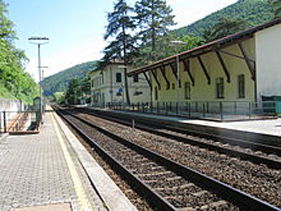One of the great unknown railway journeys of the world – in italy

One minute you’re sunbathing on the coast, in a couple of stunningly, eye-poppingly beautiful hours later you’re in Renaissance Florence
Away from the routes of the new high-speed inter-city trains, there are still the old, smaller railways and trains, attractive not for their speed but for their ambiance and the scenery they run through. Relics of an older Italy, these railways criss-cross the country, revealing fascinating lesser-known places.
One such route is covered by the Faenza – Florence line, through the spectacular hills of Romagna and the majestic Apennines to arrive in stunning Florence.
The Faenza (ceramics city) – Florence railway line was established way back in 1839, the brainchild of Grand-duke Leopold of Tuscany, to link Italy’s east and west coasts in Romagna and Tuscany. The building of this railway symbolised Italian unity. A poster issued by the city-state of Faenza in 1893 stated, with a certain amount of hyperbole:
"Faenza and hospitable Romagna embraced friendly Florence and culturally-rich Tuscany; together they joyfully celebrated their long-awaited reconciliation, thus underlining the firm belief that a resurgence of cultural inspiration and well-being will spring from the depths of the Apennines with the power of the steam engine".
Starting from Faenza, in Romagna, the train climbs to Brisighella. By this point, the broad plain stretching from Faenza to the Adriatic has been replaced by the gentle hills of Romagna. The little medieval town is perched on a tall gypsum outcrop which provides its microclimate ideal for growing olives and wine.

The streets of the fascinating town snake upwards to the top of the hill. The most famous of these ways is Via del Borgo, also called the donkey path. It’s a raised, covered road which follows the first floor of a long building, lit by archways of varying sizes. Via del Borgo retains all the fascination of an earlier age, when caravans of donkeys passed through on their way to the nearby limestone quarries.
Brisighella’s Lamone valley produces one of Italy’s best olive oils. Olives have been cultivated here for a thousand years, on the beautiful hillsides protected from the cold winds,right on the northern limit of olive trees on the Adriatic-facing slopes.

The Pieve del Tho’ is situated 1.5 kilometres from Brisighella and is the oldest pieve (parish) in the Valle del Lamone. Its origins are somewhat obscure, going back to Galla Placida, daughter of Theodosius, who is said to have had it built on the remains of a Roman temple dedicated to Jupiter.
Leaving Brisighella, the train heads towards the Apennines. Here, the landscape changes, becoming wilder and more remote. Deep gorges and desolate mountains cloaked in endless forests are the only things visible from the train.
The last station before reaching the heart of the mountains is Marradi.
Here the train reaches the full height of the pass, 578.38 metres above sea level.
Nowadays, the town is well-known for being the home of the poet Dino Campana and for its ancient sweet chestnut trees. Marradi lies few kilometres from the boundary between Romagna and Tuscany, in the heart of the Lamone valley. Here, surrounded by forest, rivers, streams and mountains, the ancient, rural way of life lives on.
Marradi is the land of the Marron Buono (chestnut), recognised internationally as being of the highest quality. The local cuisine benefits from the myriad of exquisite recipes based on the chestnut, especially the Torta di Marroni di Marradi (Marradi Chestnut cake), emblem of the local gastronomic culture, the recipe for which is jealously guarded in the memories of the old folk.
It is possible to try this delicious dish during the historic Sagra delle Castagne (chestnut festival) held during the month of October, which can be reached by a steam train journey starting from Rimini or Florence.
Leaving the Apennines towards Florence, the train passes through a vast open area among fields of wheat, soya beans and sunflowers, descending towards Ronta, the first town in the Mugello valley. Borgo San Lorenzo is the doorway to the Mugello The town is surrounded by fields, mountains and the wonders of nature: age-old vineyards and olive groves, thousand-year-old churches, ancient farmhouses and geometrically laid out vegetable gardens.
This stretch of railway was bombed and destroyed during the Second World War and did not undergo reconstruction until the 1980s. On January 14, 1999, the railway was officially inaugurated for the second time in its history.
Now, the line is complete and you can travel from Ravenna to Livorno , passing through Faenza , Brisighella, Marradi, Borgo San Lorenzo and Florence , cutting across the peninsula from north-east to south-west.
 Get a taste of the eye-popping scenery, and stunning medieval villages and towns, plus hopefully a little local wine, olive oil and chestnut tart!
Get a taste of the eye-popping scenery, and stunning medieval villages and towns, plus hopefully a little local wine, olive oil and chestnut tart!
It will all set you up for the wonder that is Florence.
And all for €20 return!
Valere Tjolle
@ValereTjolle [email protected]
 United Kingdom
United Kingdom United States
United States Asia Pacific
Asia Pacific












































Dozens fall ill in P&O Cruises ship outbreak
Boy falls to death on cruise ship
Turkish Airlines flight in emergency landing after pilot dies
Unexpected wave rocks cruise ship
Woman dies after going overboard in English Channel